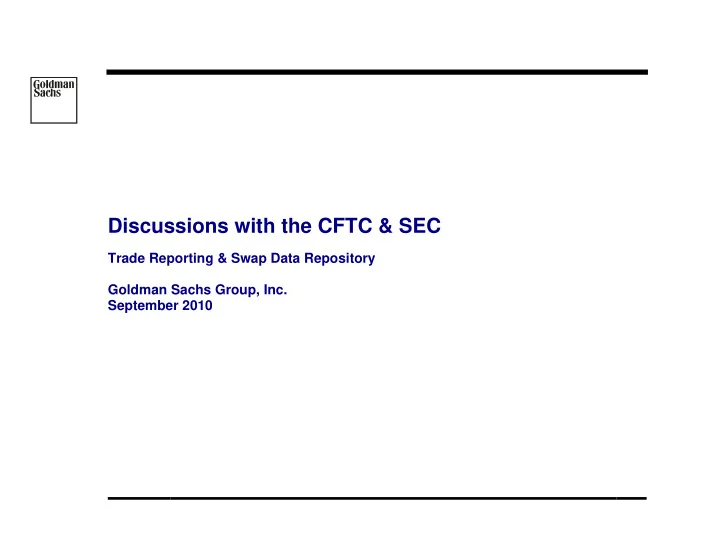

Discussions with the CFTC & SEC Trade Reporting & Swap Data Repository Goldman Sachs Group, Inc. September 2010
Trade Reporting Agenda 1) Considerations in rulemaking 2) Global regulatory consistency 3) Market precedent 4) Non-cleared product(s) Considerations in Rulemaking Currently in the OTC markets, clients can choose whether to hedge exposures in a single risk transfer (paying a one-time transaction cost in order to transfer all market risk to a single liquidity provider) or in multiple tickets over time (paying many, potentially lower, transaction costs, but bearing the risk of adverse market moves during an ongoing execution process) In certain reporting regimes, the reporting event may impact the market in ways for which the liquidity provider will adjust In the worst case, the cost of providing liquidity will increase to the point that a single risk transfer transaction becomes uneconomic for the client, thereby removing an important form of hedging option A post trade reporting regime should try to achieve transparency while maintaining client choice Alternative reporting arrangement for block transactions (based on market liquidity and the size of the trade) will protect liquidity and achieve transparency 2
Trade Reporting Global regulatory consistency CESR recommendation to EC on post trade transparency Based on discussion with policymakers & regulators across 27 EU Member States and a 1-month stakeholder consultation “CESR is of the view that the calibration of thresholds and time delays for the proposed regime should ideally be based on liquidity of the asset in question” Proposed construct: Transaction Size (Net) Info Published Timing of Publication Below Level 1 Price and volume of transaction As close to real time as possible Level 1 Price and volume of transaction EOD Price and indication that trade is above Level Level 2 EOD 2 threshold (no volume) 3
Trade Reporting Market precedent TRACE Reporting NASD introduced TRACE in July 2002 in an effort to increase price transparency in the US corporate debt market The system captures & disseminates consolidated information on secondary market transactions in publicly traded TRACE-eligible securities As of TRACE system open, NASD began disseminating price and other transaction information on certain debt securities transactions immediately upon receipt - Initially, transaction information was disseminated on 500 corporate debt securities, including 50 representative high yield bonds, with additional groups of bonds being added over time - This incremental phase-in approach allowed NASD to study the impact of increased price disclosure upon market liquidity Non-Cleared Products Real time reporting of non-standard transactions poses additional issues 4
Swap Data Repository Agenda 1) Data aggregation and reporting approach a. Global and/or local data repositories b. Central clearers performing Swap Data Repository functions 2) Data Standards 3) Leveraging currently available regulatory reporting a. What information is reportable b. What is method of reporting 4) Which market participants will be responsible for reporting High Level Public Policy Goal Swap Data Repositories (SDRs) have existed for several years now in certain derivatives products and have helped to achieve the following: Transparency of all positions, providing regulators with ability to analyze and implement product standardization process for applicable regulators and market participants Greater transparency on the size of overall market and its components Greater clarity of trade portfolios for the parties themselves in addition for the primary regulators, which is essential particularly in times of counterparty distress or default Third Party validation of market participants’ positions 5
Swap Data Repository Further advances may be achieved through SDR requirement by: Adopting a utility based model where possible to avoid an additional layer of costs for market participants Building a SDR per asset class and leveraging data repositories already resident within the central clearers Working with regulators internationally to implement a global SDR per asset class Ensuring common data reporting standards are utilized to ease data transmission and analysis Extending the use of FpML as the reporting infrastructure develops which is a data reporting language already widely used in the marketplace today Of course, centralizing industry data in SDRs creates significant risk around data protection and privacy and we regard it as essential to build and encourage extensive safeguards ensuring adequate business resilience, data privacy, integrity, and data completeness including secure transmissions to the eligible recipients. 6
Recommend
More recommend